Business of Tourism and Hospitality: Great Barrier Reef Report
VerifiedAdded on 2020/03/04
|5
|1217
|44
Report
AI Summary
This report provides a comprehensive analysis of the business of tourism and hospitality in the Whitsundays, focusing on the Great Barrier Reef. It examines the economic, social, political, legal, and technological factors influencing the region's tourism industry. The report highlights the economic benefits, such as job creation and infrastructure development, while also addressing the importance of environmental conservation, particularly the protection of the Great Barrier Reef. It discusses the roles of government, local communities, and technological advancements in promoting sustainable tourism. The report concludes by emphasizing the need for continued efforts to balance tourism growth with environmental protection to ensure the long-term viability of the industry. The study also references the impact of coral bleaching events and the importance of initiatives like 'Eye on the Reef' in monitoring and protecting the reef.
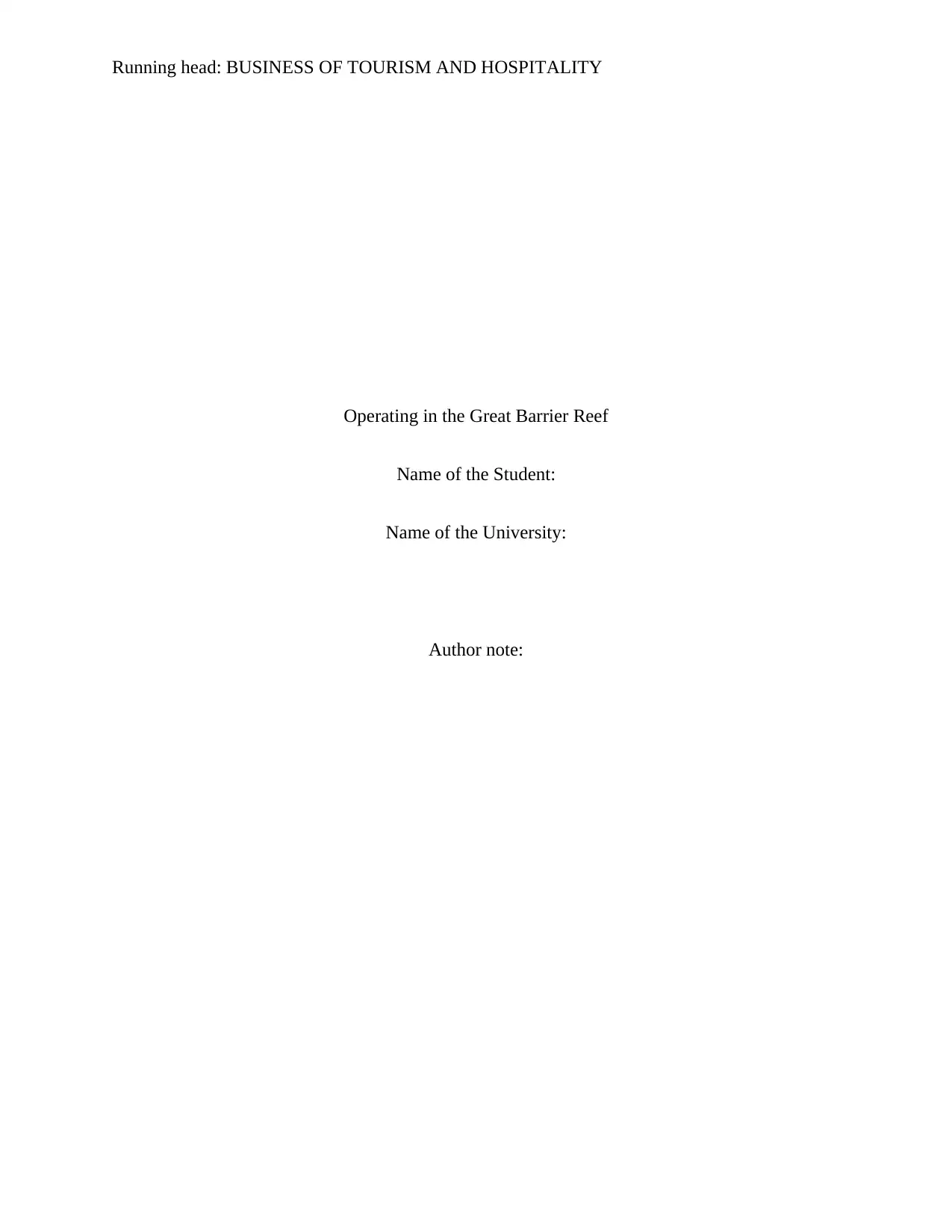
Running head: BUSINESS OF TOURISM AND HOSPITALITY
Operating in the Great Barrier Reef
Name of the Student:
Name of the University:
Author note:
Operating in the Great Barrier Reef
Name of the Student:
Name of the University:
Author note:
Paraphrase This Document
Need a fresh take? Get an instant paraphrase of this document with our AI Paraphraser
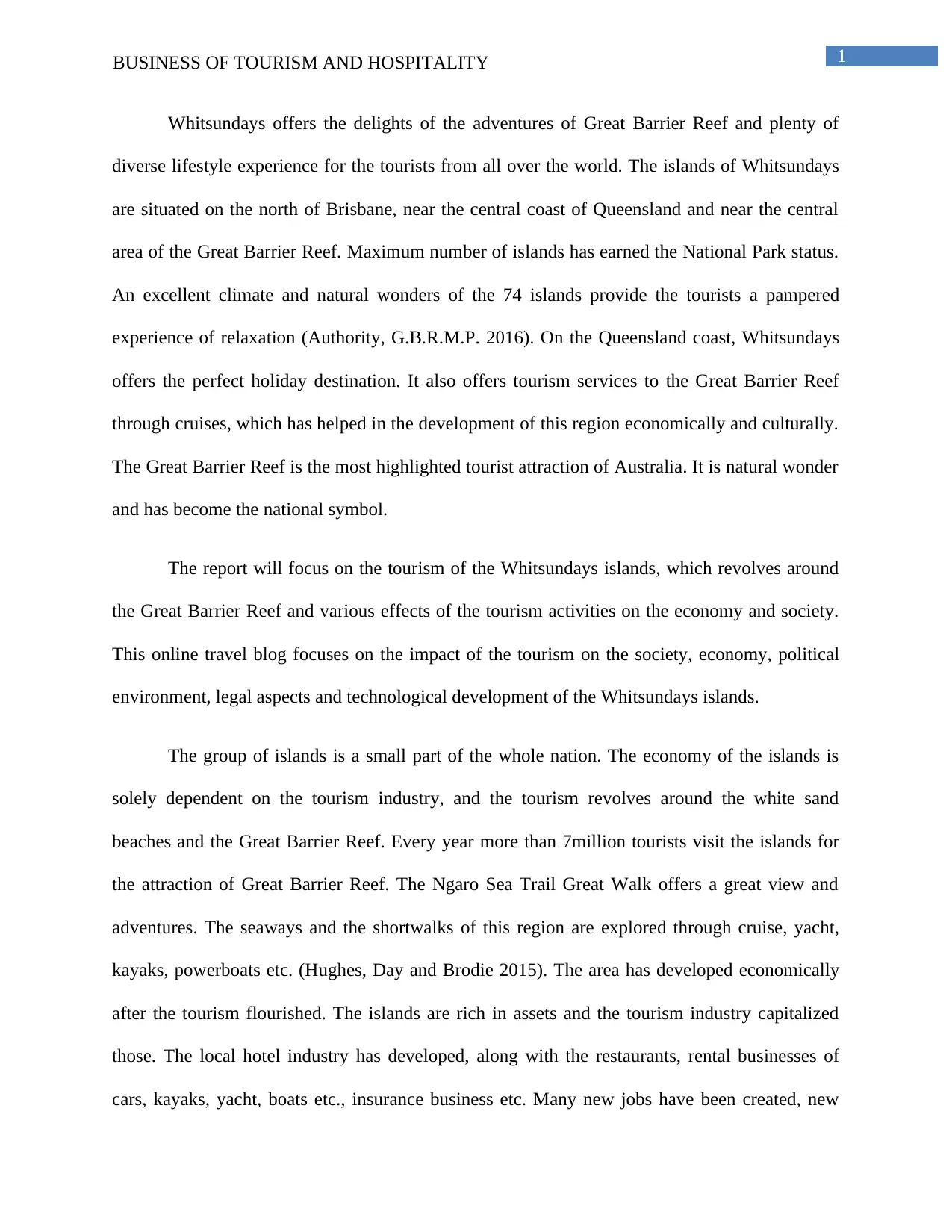
1BUSINESS OF TOURISM AND HOSPITALITY
Whitsundays offers the delights of the adventures of Great Barrier Reef and plenty of
diverse lifestyle experience for the tourists from all over the world. The islands of Whitsundays
are situated on the north of Brisbane, near the central coast of Queensland and near the central
area of the Great Barrier Reef. Maximum number of islands has earned the National Park status.
An excellent climate and natural wonders of the 74 islands provide the tourists a pampered
experience of relaxation (Authority, G.B.R.M.P. 2016). On the Queensland coast, Whitsundays
offers the perfect holiday destination. It also offers tourism services to the Great Barrier Reef
through cruises, which has helped in the development of this region economically and culturally.
The Great Barrier Reef is the most highlighted tourist attraction of Australia. It is natural wonder
and has become the national symbol.
The report will focus on the tourism of the Whitsundays islands, which revolves around
the Great Barrier Reef and various effects of the tourism activities on the economy and society.
This online travel blog focuses on the impact of the tourism on the society, economy, political
environment, legal aspects and technological development of the Whitsundays islands.
The group of islands is a small part of the whole nation. The economy of the islands is
solely dependent on the tourism industry, and the tourism revolves around the white sand
beaches and the Great Barrier Reef. Every year more than 7million tourists visit the islands for
the attraction of Great Barrier Reef. The Ngaro Sea Trail Great Walk offers a great view and
adventures. The seaways and the shortwalks of this region are explored through cruise, yacht,
kayaks, powerboats etc. (Hughes, Day and Brodie 2015). The area has developed economically
after the tourism flourished. The islands are rich in assets and the tourism industry capitalized
those. The local hotel industry has developed, along with the restaurants, rental businesses of
cars, kayaks, yacht, boats etc., insurance business etc. Many new jobs have been created, new
Whitsundays offers the delights of the adventures of Great Barrier Reef and plenty of
diverse lifestyle experience for the tourists from all over the world. The islands of Whitsundays
are situated on the north of Brisbane, near the central coast of Queensland and near the central
area of the Great Barrier Reef. Maximum number of islands has earned the National Park status.
An excellent climate and natural wonders of the 74 islands provide the tourists a pampered
experience of relaxation (Authority, G.B.R.M.P. 2016). On the Queensland coast, Whitsundays
offers the perfect holiday destination. It also offers tourism services to the Great Barrier Reef
through cruises, which has helped in the development of this region economically and culturally.
The Great Barrier Reef is the most highlighted tourist attraction of Australia. It is natural wonder
and has become the national symbol.
The report will focus on the tourism of the Whitsundays islands, which revolves around
the Great Barrier Reef and various effects of the tourism activities on the economy and society.
This online travel blog focuses on the impact of the tourism on the society, economy, political
environment, legal aspects and technological development of the Whitsundays islands.
The group of islands is a small part of the whole nation. The economy of the islands is
solely dependent on the tourism industry, and the tourism revolves around the white sand
beaches and the Great Barrier Reef. Every year more than 7million tourists visit the islands for
the attraction of Great Barrier Reef. The Ngaro Sea Trail Great Walk offers a great view and
adventures. The seaways and the shortwalks of this region are explored through cruise, yacht,
kayaks, powerboats etc. (Hughes, Day and Brodie 2015). The area has developed economically
after the tourism flourished. The islands are rich in assets and the tourism industry capitalized
those. The local hotel industry has developed, along with the restaurants, rental businesses of
cars, kayaks, yacht, boats etc., insurance business etc. Many new jobs have been created, new
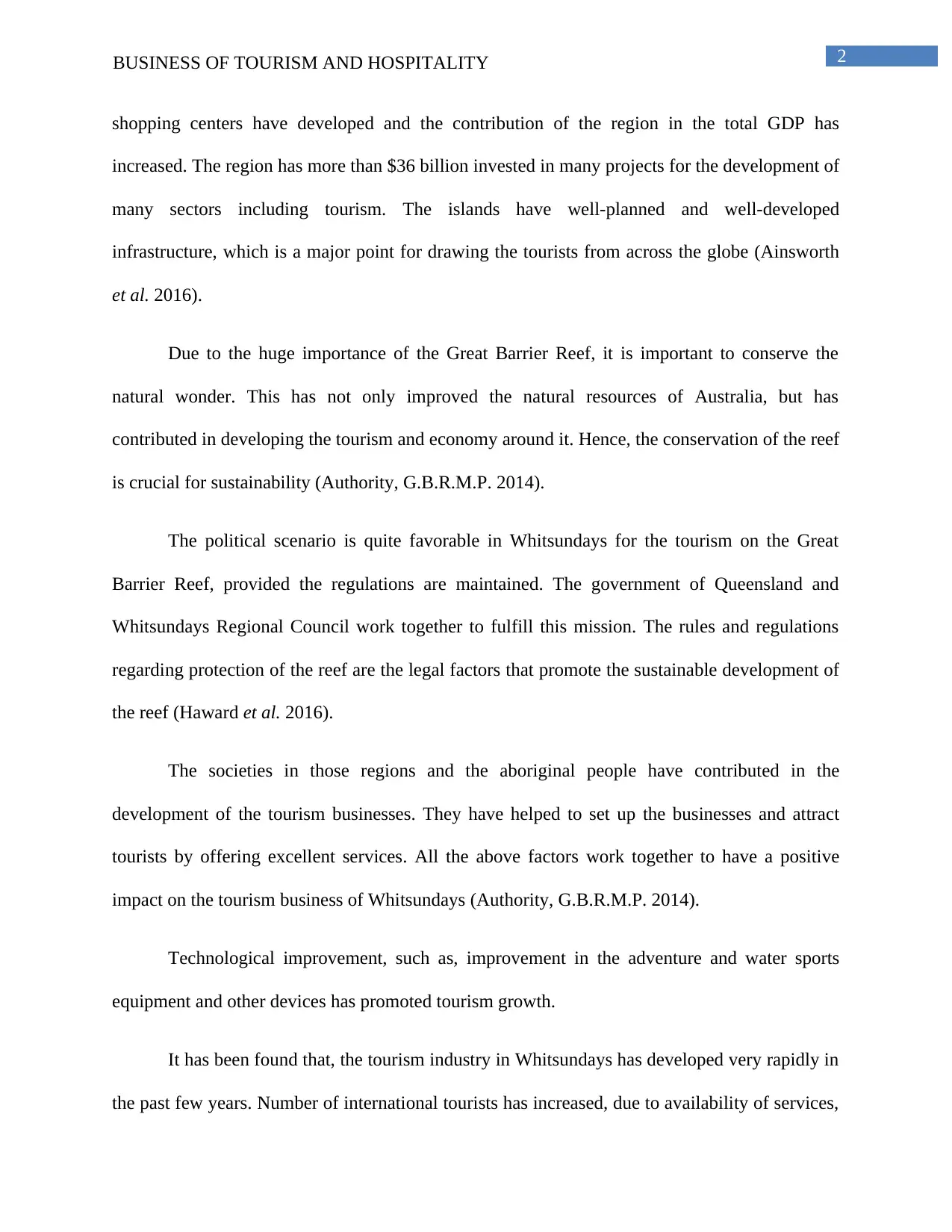
2BUSINESS OF TOURISM AND HOSPITALITY
shopping centers have developed and the contribution of the region in the total GDP has
increased. The region has more than $36 billion invested in many projects for the development of
many sectors including tourism. The islands have well-planned and well-developed
infrastructure, which is a major point for drawing the tourists from across the globe (Ainsworth
et al. 2016).
Due to the huge importance of the Great Barrier Reef, it is important to conserve the
natural wonder. This has not only improved the natural resources of Australia, but has
contributed in developing the tourism and economy around it. Hence, the conservation of the reef
is crucial for sustainability (Authority, G.B.R.M.P. 2014).
The political scenario is quite favorable in Whitsundays for the tourism on the Great
Barrier Reef, provided the regulations are maintained. The government of Queensland and
Whitsundays Regional Council work together to fulfill this mission. The rules and regulations
regarding protection of the reef are the legal factors that promote the sustainable development of
the reef (Haward et al. 2016).
The societies in those regions and the aboriginal people have contributed in the
development of the tourism businesses. They have helped to set up the businesses and attract
tourists by offering excellent services. All the above factors work together to have a positive
impact on the tourism business of Whitsundays (Authority, G.B.R.M.P. 2014).
Technological improvement, such as, improvement in the adventure and water sports
equipment and other devices has promoted tourism growth.
It has been found that, the tourism industry in Whitsundays has developed very rapidly in
the past few years. Number of international tourists has increased, due to availability of services,
shopping centers have developed and the contribution of the region in the total GDP has
increased. The region has more than $36 billion invested in many projects for the development of
many sectors including tourism. The islands have well-planned and well-developed
infrastructure, which is a major point for drawing the tourists from across the globe (Ainsworth
et al. 2016).
Due to the huge importance of the Great Barrier Reef, it is important to conserve the
natural wonder. This has not only improved the natural resources of Australia, but has
contributed in developing the tourism and economy around it. Hence, the conservation of the reef
is crucial for sustainability (Authority, G.B.R.M.P. 2014).
The political scenario is quite favorable in Whitsundays for the tourism on the Great
Barrier Reef, provided the regulations are maintained. The government of Queensland and
Whitsundays Regional Council work together to fulfill this mission. The rules and regulations
regarding protection of the reef are the legal factors that promote the sustainable development of
the reef (Haward et al. 2016).
The societies in those regions and the aboriginal people have contributed in the
development of the tourism businesses. They have helped to set up the businesses and attract
tourists by offering excellent services. All the above factors work together to have a positive
impact on the tourism business of Whitsundays (Authority, G.B.R.M.P. 2014).
Technological improvement, such as, improvement in the adventure and water sports
equipment and other devices has promoted tourism growth.
It has been found that, the tourism industry in Whitsundays has developed very rapidly in
the past few years. Number of international tourists has increased, due to availability of services,
⊘ This is a preview!⊘
Do you want full access?
Subscribe today to unlock all pages.

Trusted by 1+ million students worldwide
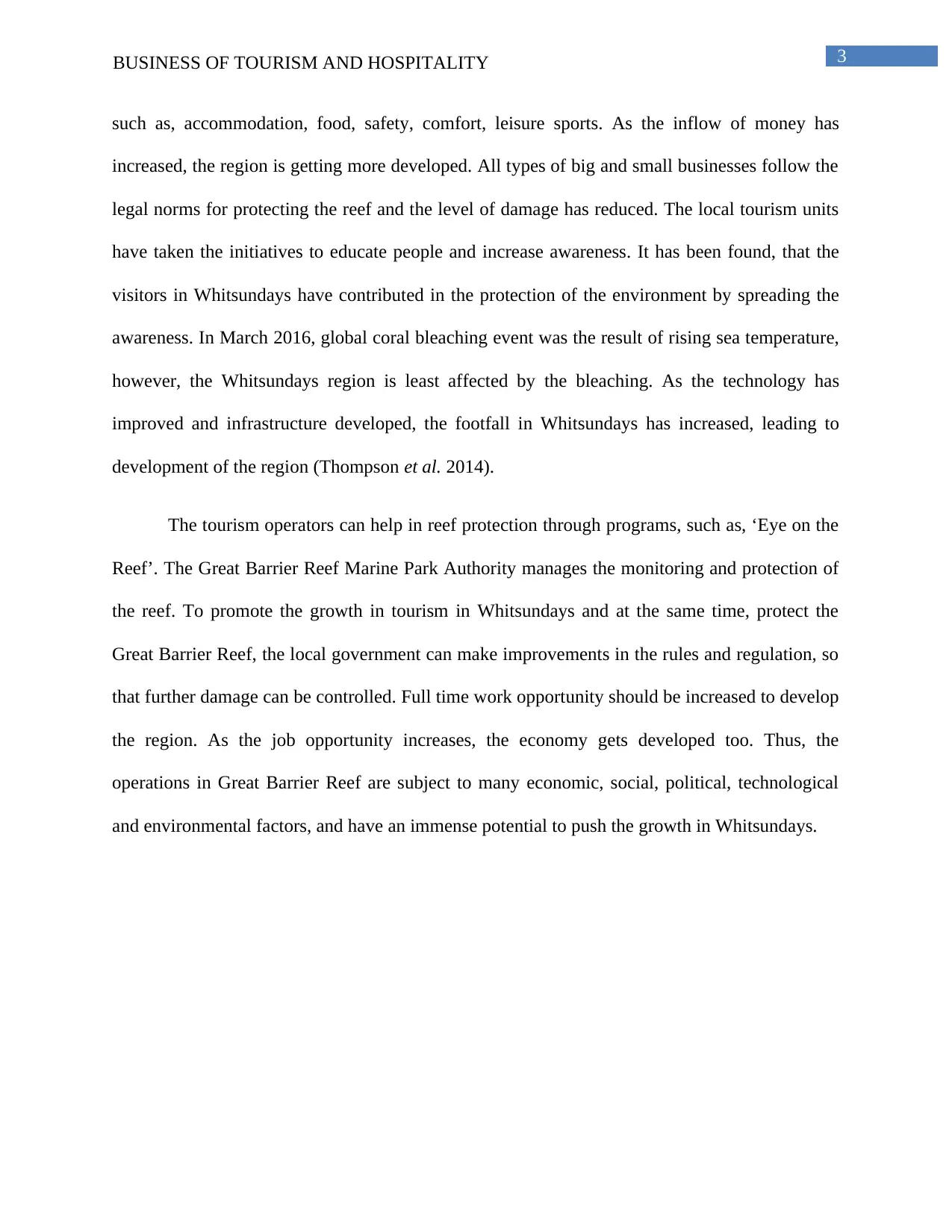
3BUSINESS OF TOURISM AND HOSPITALITY
such as, accommodation, food, safety, comfort, leisure sports. As the inflow of money has
increased, the region is getting more developed. All types of big and small businesses follow the
legal norms for protecting the reef and the level of damage has reduced. The local tourism units
have taken the initiatives to educate people and increase awareness. It has been found, that the
visitors in Whitsundays have contributed in the protection of the environment by spreading the
awareness. In March 2016, global coral bleaching event was the result of rising sea temperature,
however, the Whitsundays region is least affected by the bleaching. As the technology has
improved and infrastructure developed, the footfall in Whitsundays has increased, leading to
development of the region (Thompson et al. 2014).
The tourism operators can help in reef protection through programs, such as, ‘Eye on the
Reef’. The Great Barrier Reef Marine Park Authority manages the monitoring and protection of
the reef. To promote the growth in tourism in Whitsundays and at the same time, protect the
Great Barrier Reef, the local government can make improvements in the rules and regulation, so
that further damage can be controlled. Full time work opportunity should be increased to develop
the region. As the job opportunity increases, the economy gets developed too. Thus, the
operations in Great Barrier Reef are subject to many economic, social, political, technological
and environmental factors, and have an immense potential to push the growth in Whitsundays.
such as, accommodation, food, safety, comfort, leisure sports. As the inflow of money has
increased, the region is getting more developed. All types of big and small businesses follow the
legal norms for protecting the reef and the level of damage has reduced. The local tourism units
have taken the initiatives to educate people and increase awareness. It has been found, that the
visitors in Whitsundays have contributed in the protection of the environment by spreading the
awareness. In March 2016, global coral bleaching event was the result of rising sea temperature,
however, the Whitsundays region is least affected by the bleaching. As the technology has
improved and infrastructure developed, the footfall in Whitsundays has increased, leading to
development of the region (Thompson et al. 2014).
The tourism operators can help in reef protection through programs, such as, ‘Eye on the
Reef’. The Great Barrier Reef Marine Park Authority manages the monitoring and protection of
the reef. To promote the growth in tourism in Whitsundays and at the same time, protect the
Great Barrier Reef, the local government can make improvements in the rules and regulation, so
that further damage can be controlled. Full time work opportunity should be increased to develop
the region. As the job opportunity increases, the economy gets developed too. Thus, the
operations in Great Barrier Reef are subject to many economic, social, political, technological
and environmental factors, and have an immense potential to push the growth in Whitsundays.
Paraphrase This Document
Need a fresh take? Get an instant paraphrase of this document with our AI Paraphraser
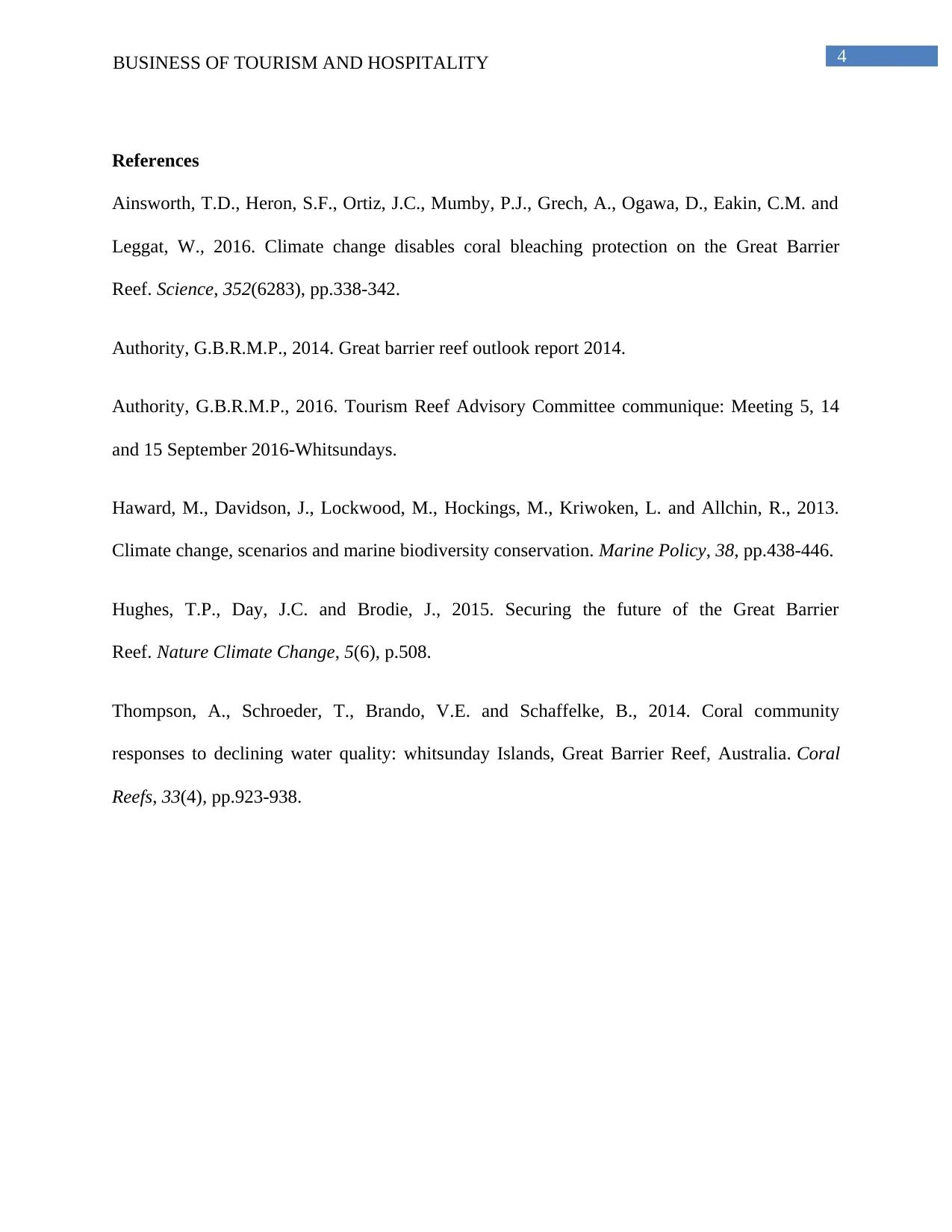
4BUSINESS OF TOURISM AND HOSPITALITY
References
Ainsworth, T.D., Heron, S.F., Ortiz, J.C., Mumby, P.J., Grech, A., Ogawa, D., Eakin, C.M. and
Leggat, W., 2016. Climate change disables coral bleaching protection on the Great Barrier
Reef. Science, 352(6283), pp.338-342.
Authority, G.B.R.M.P., 2014. Great barrier reef outlook report 2014.
Authority, G.B.R.M.P., 2016. Tourism Reef Advisory Committee communique: Meeting 5, 14
and 15 September 2016-Whitsundays.
Haward, M., Davidson, J., Lockwood, M., Hockings, M., Kriwoken, L. and Allchin, R., 2013.
Climate change, scenarios and marine biodiversity conservation. Marine Policy, 38, pp.438-446.
Hughes, T.P., Day, J.C. and Brodie, J., 2015. Securing the future of the Great Barrier
Reef. Nature Climate Change, 5(6), p.508.
Thompson, A., Schroeder, T., Brando, V.E. and Schaffelke, B., 2014. Coral community
responses to declining water quality: whitsunday Islands, Great Barrier Reef, Australia. Coral
Reefs, 33(4), pp.923-938.
References
Ainsworth, T.D., Heron, S.F., Ortiz, J.C., Mumby, P.J., Grech, A., Ogawa, D., Eakin, C.M. and
Leggat, W., 2016. Climate change disables coral bleaching protection on the Great Barrier
Reef. Science, 352(6283), pp.338-342.
Authority, G.B.R.M.P., 2014. Great barrier reef outlook report 2014.
Authority, G.B.R.M.P., 2016. Tourism Reef Advisory Committee communique: Meeting 5, 14
and 15 September 2016-Whitsundays.
Haward, M., Davidson, J., Lockwood, M., Hockings, M., Kriwoken, L. and Allchin, R., 2013.
Climate change, scenarios and marine biodiversity conservation. Marine Policy, 38, pp.438-446.
Hughes, T.P., Day, J.C. and Brodie, J., 2015. Securing the future of the Great Barrier
Reef. Nature Climate Change, 5(6), p.508.
Thompson, A., Schroeder, T., Brando, V.E. and Schaffelke, B., 2014. Coral community
responses to declining water quality: whitsunday Islands, Great Barrier Reef, Australia. Coral
Reefs, 33(4), pp.923-938.
1 out of 5
Related Documents
Your All-in-One AI-Powered Toolkit for Academic Success.
+13062052269
info@desklib.com
Available 24*7 on WhatsApp / Email
![[object Object]](/_next/static/media/star-bottom.7253800d.svg)
Unlock your academic potential
Copyright © 2020–2025 A2Z Services. All Rights Reserved. Developed and managed by ZUCOL.





